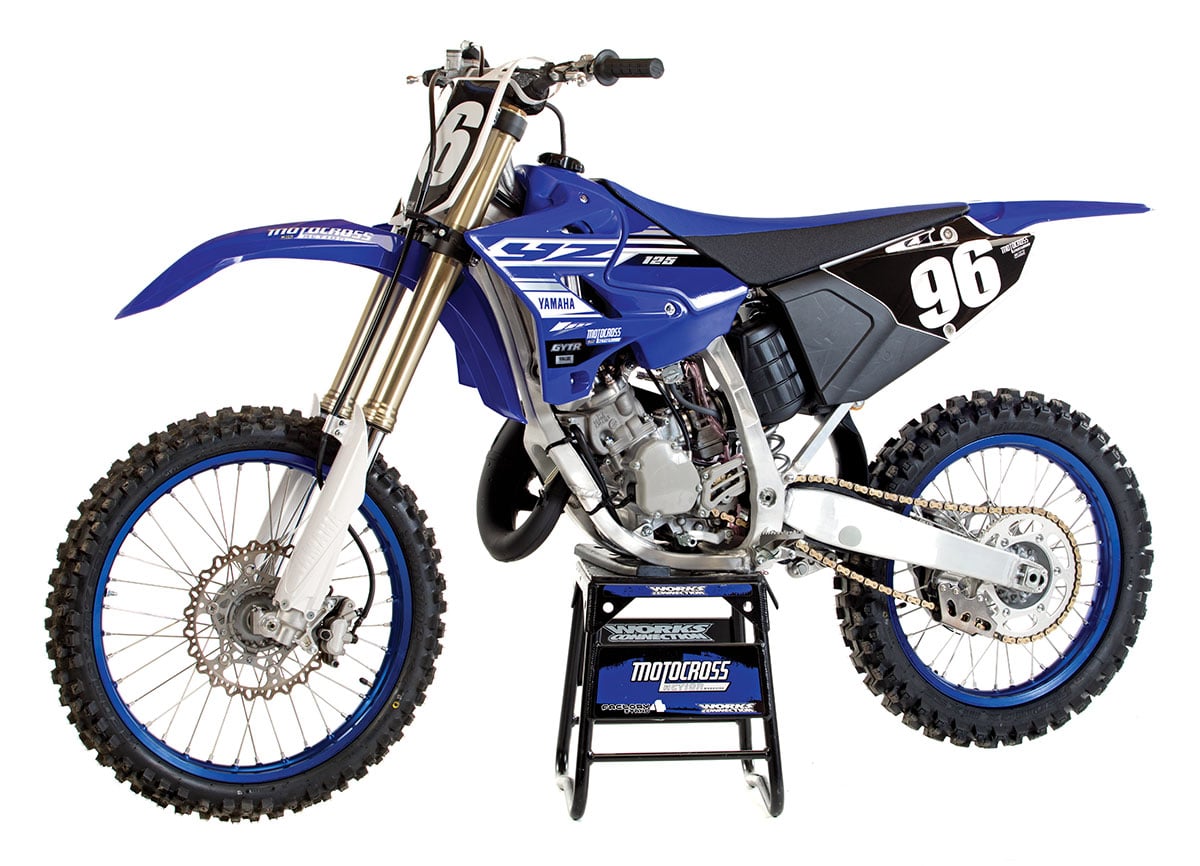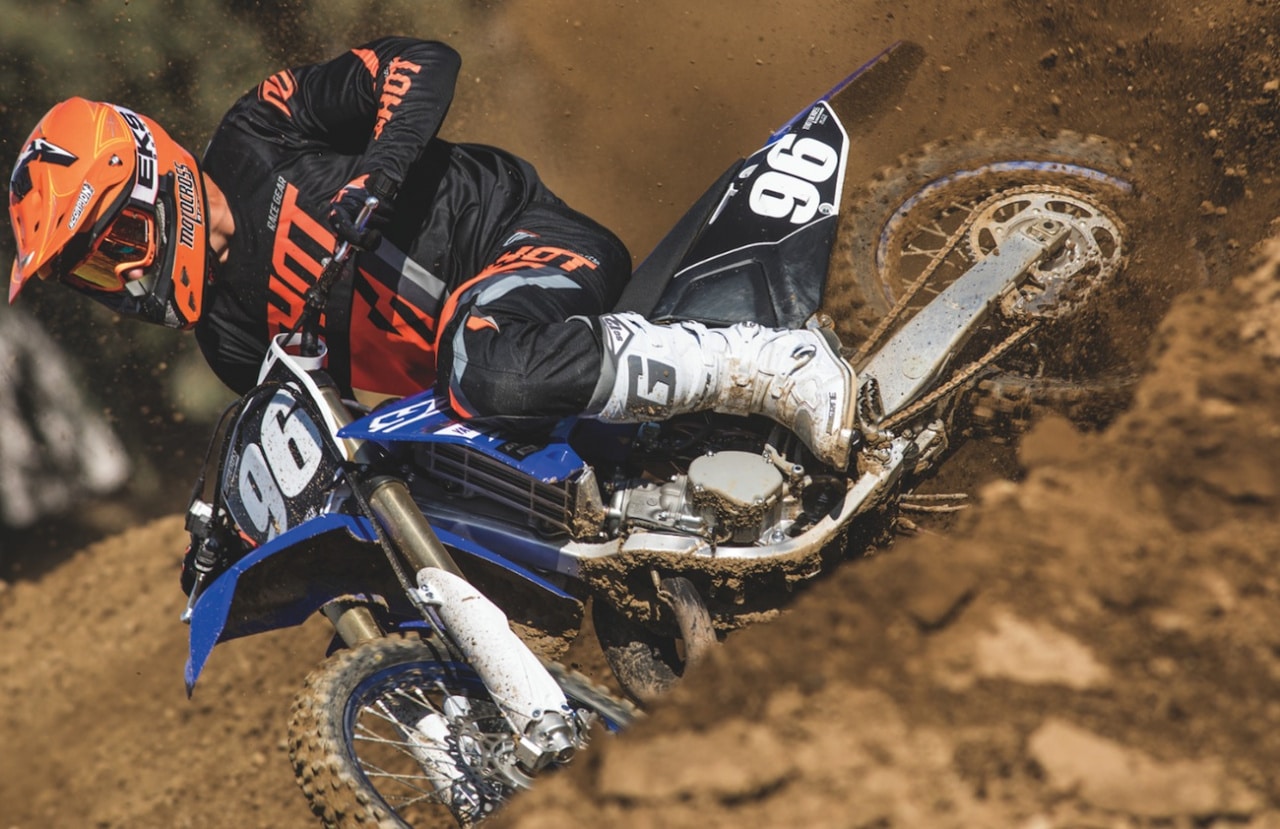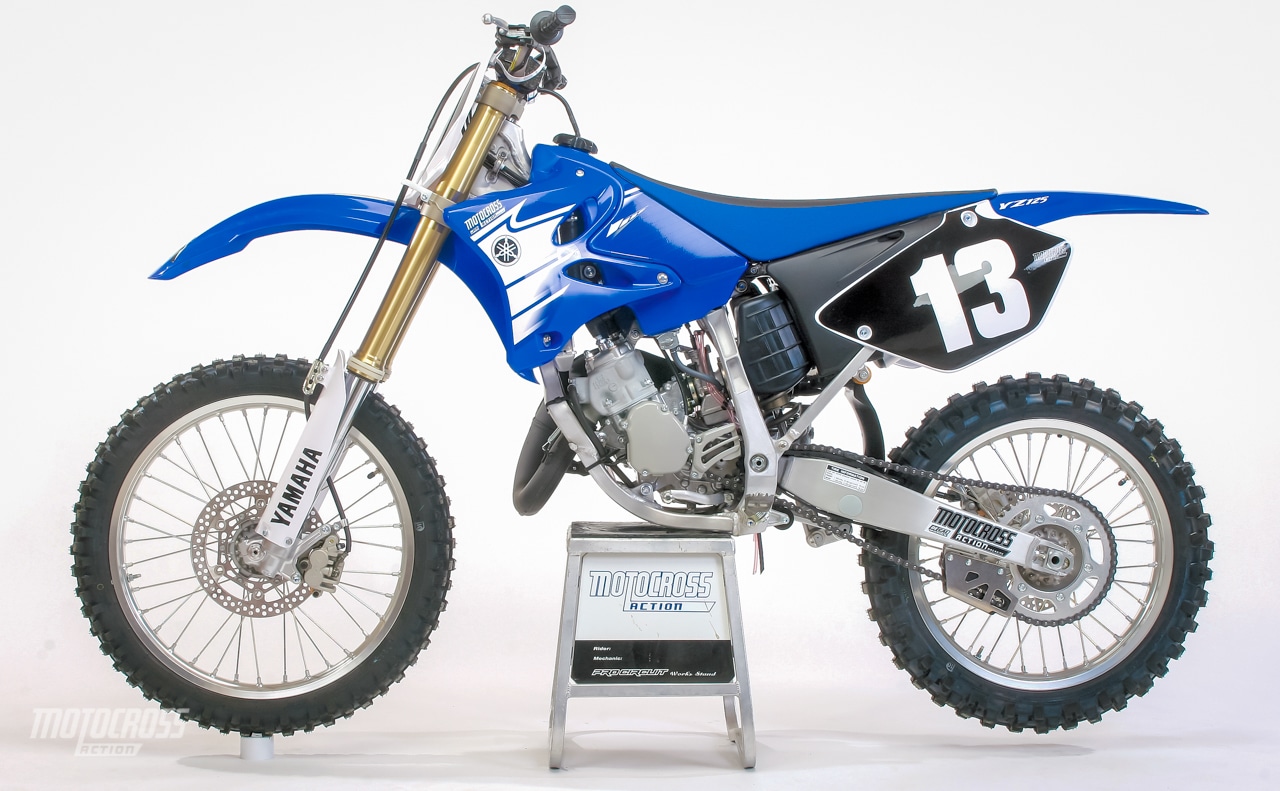MXA RACE TEST: 2019 YAMAHA YZ125 TWO-STROKE

Q: FIRST AND FOREMOST, IS THE 2019 YAMAHA YZ125 BETTER THAN THE 2018 YZ125?
A: No. The only change that Yamaha made from 2018 to 2019 is BNG (bold new graphics). Thank goodness Yamaha didn’t raise the price again this year. The bike still has the same $6499 price tag for 2019. Since the bike hasn’t had any major updates since 2006, and used YZ125 two-strokes are plentiful and easy to rebuild, the 2019 Yamaha YZ125’s biggest competitor isn’t Husqvarna, KTM or TM; it’s used YZ125s. Instead of going to the dealership, most people are buying their YZ125s from the want ads. There will come a time when Yamaha will be forced to reinvent its two-stroke line if it wants to keep selling two-stroke motorcycles.
Q: DO WE STILL LIKE THE 2019 YZ125?
A: Yes, we love this bike! Many people, including the MXA wrecking crew, say that this is the most fun bike on the market. The 125cc smoker is so light that it handles like a dream. A good rider can maneuver the bike anywhere he wants on the racetrack—and you haven’t lived until you’ve blown by your buddies’ CRF450s on the back straight; however, a good rider on a KTM 125SX or Husky TC125 will knock the doors off a YZ125 on the back straight.  The most visually dramatic change in the YZ125’s 13-year history was the change to “arrow” plastic in 2015.
The most visually dramatic change in the YZ125’s 13-year history was the change to “arrow” plastic in 2015.
Q: HOW DOES IT RUN ON THE DYNO?
A: Surprisingly, the YZ125 is better from idle to 8000 rpm than its KTM or Husqvarna competition. After riding the KTM and YZ back to back, the MXA test riders noted that the YZ125 had better throttle response and pickup from low to mid. The YZ125 was also more adept at erasing our mistakes. It was easier to grab the clutch and get back into the power on the YZ than on the 125SX.
Unfortunately for the YZ125, after 7000 rpm, the balance of power shifts from the Yamaha to the KTM. The YZ boasts 16.3 horsepower at 7000 rpm, while the KTM is only at 15.37 horsepower. Unfortunately for the old-faithful YZ125, the KTM flies past it as the rpm climb. This is where we noticed the biggest difference between the two tiddlers on the track. In a nutshell, the Yamaha gets up to speed quickly but then flattens out at the exact point where the KTM is just getting started. The KTM climbs to 29.45 horses at 9500 rpm, while the YZ is down 1-1/2 horses. The Yamaha’s horsepower peaks at 11,600 rpm with only 35.36 horsepower, while the KTM peaks at 11,300 rpm at 38.23 horsepower. That 3-pony difference is huge on a small-bore engine.
Q: IS THIS BIKE GOOD FOR YOUNGSTERS?
A: Yes. Most AMA Pro racers put their kids on a YZ125 before they even dream of letting them race a 250 four-stroke. The YZ125 is great for young riders moving up from an 85cc or for less-experienced riders who want to get better. Because of the uniqueness of a 125cc powerband, it is a great learning tool for an entry-level rider. It teaches the importance of shift points, maintaining momentum, late braking and energy management. And, the YZ125 is better at teaching these skills than the KTM 125SX or Husky TC125. Why? The YZ125’s better throttle response down low requires less commitment to roll the throttle on than the Austrian 125s. The Austrian bikes require an aggressive attack from low-to-mid to get to their more-effective higher-rpm powerbands. Everybody knows that to ride a 125 to its full potential, you need to be high in the rpm range and wide open. For an intermediate or Pro, this is fun, but for less-experienced riders, it requires some trial and error.
Q: CAN THE YZ125 STILL BE COMPETITIVE AGAINST THE NEW KTM 125SX?
A: Yes, but not without spending your hard-earned money. The blue bike retails for $700 less than the KTM 125SX and $800 less than the clone-like Husky TC125. That extra cash can be used to buy bolt-on power for the YZ125 that will make a big difference. What hop-up parts should you buy? Here are a few suggestions that will get you the most bang for your buck.
(1) Pipe. For $250, you can gain around 2 horsepower with an aftermarket pipe (add in $135 for a silencer). We have had great luck with both Pro Circuit and FMF pipes.
(2) Reed cage. We run a Boyesen Rad Valve or Moto Tassinari VForce4 reed cage to broaden the power. The $179.95 Rad Valve and $168 VForce4 reed cage are complete replacement reed blocks and valve assemblies.
(3) Cylinder/head mods. A reputable tuner can get more power out of the YZ125’s cylinder and head for under $500; however, it may require race gas.
(4) Gearing. Adding one tooth to the rear (going from a 48 to a 49) will perk up second gear, get you to third gear sooner, and make the overall ratios between the six gears more user-friendly.
(5) Price calculator. If you are thinking of buying the 2019 YZ125 because it is $700 cheaper than the 2019 KTM 125SX, you might want to add up the mods above to learn that you are no longer saving money with the blue bike.
Q: WHAT’S IT LIKE RIDING THE YZ125 AND KTM 125SX BACK TO BACK?
A: If you own a YZ125, don’t ever throw a leg over a KTM 125SX. Why not? It will cost you a lot of money, because you will not go back to the Yamaha after feeling the top-end power on the KTM.
Q: WHAT CHANGES HAVE BEEN MADE TO THE YAMAHA YZ125 SINCE 2006?
A: The best thing that Yamaha’s engineers ever did to the YZ125 was to spec Kayaba SSS suspension components in 2006. Yamaha’s suspension went from 30-percent speed-sensitive damping to 90-percent speed-sensitive. As for the shock, it was as close to a works shock as any production bike shock has ever come. It had an 18mm shock shaft (instead of 16mm), Kashima-coated internals, a 30-percent-larger reservoir and a titanium shock spring.
Sadly, 2006 was the last time any single mod made a major difference in YZ125 performance. Here’s a rundown of the changes Yamaha has made since 2006.
2007: The fork stanchion tubes were tapered into a thinner midsection and new damping was added. The steel components on the Kayaba shock were replaced with lighter aluminum pieces. Over-sized Pro Taper Contour bars replaced the old-school steel handlebars. Aluminum bolts replaced the previous steel bolts on many parts of the bike. The silencer’s perf-core section was shortened by 75mm to improve throttle response without increasing sound.
2008: The YZ125 inherited the front-brake caliper, fork stanchions, lower fork bracket and a chain guide from the current YZ250F. Also, a new reed valve was added, and the front master cylinder piston was made 1.48mm smaller.
2009: Yamaha upgraded the oversized, steel, serpentine brake-hose holder with a 32-gram-lighter aluminum clamp. The 2009 YZ125 also earned a new seat cover and a new Dunlop 742F front tire.
2010: No changes beyond Bold New Graphics (BNG).
2011: Yamaha stopped making different bikes for the American, European and Japanese markets. The switch to one model, with a worldwide global spec, was a money-saving strategy. The majority of changes were designed to make the YZ125 powerplant run on the lower-grade gasoline of third-world countries. For example, remember when Yamaha shortened the silencer’s perf-core by 75mm in 2007 to improve throttle response? Well, under the worldwide global spec, the silencer was lengthened by 75mm and the core enlarged from 27mm to 30mm. Additionally, the 410 main jet was exchanged for a 430, while the 6BFY42-3 needle was swapped out for a 6BFY43-3 needle.
2012–2014: Besides playing hop-scotch from blue to white to a blue rear fender, these three model years only saw BNG.
2015: The big news was that the YZ125 was upgraded to the “arrow” design plastic of the Yamaha four-strokes. It also got improved SSS fork damping and a new airbox.
2016: A gold chain, black rims and BNG were added in 2016.
2017: The front rotor was increased from 250mm to 270mm, and the brake-pad material was improved.
2018: The black rims were dumped in favor of blue rims. And, as with every model change since 2006, it got mild BNG.
Q: HOW DOES THE YZ125 HANDLE?
A: Surprisingly, for a chassis that is not far from being legal in vintage racing, the YZ125 still handles like a contemporary machine. MXA tested the bike on everything from SoCal hardpack to deep sand. The biggest surprise was how well the YZ125 handled in the deep sand. In rollers big enough to swallow the YZ125, it actually floated over the bumps better than most 250cc four-strokes. Best of all, the lightweight bike was so stable that it was self-righting, even when it got sideways.
There is an old saying in the professional test-rider biz that says, “Slow bikes handle better than fast ones.” Unlike most old wives’ tales, this one is true. Fast bikes tend to wear a rider out, generate arm pump and go from stable to “oops” quickly. It is easier to make a mistake on a fast bike—or, more accurately, it is harder to make a mistake on a slow bike. The stable frame geometry and immediate low-to-mid powerband made the YZ125’s handling almost foolproof.
Q: WHAT DID WE HATE?
A: The hate list:
(1) Engine. The clutch has to be abused to keep it in the meat of the powerband. The Yamaha powerband flattens out on top, which exposes its biggest weakness.
(2) Front tire. We didn’t know any manufacturer was still spec’ing the less-than-stellar Dunlop MX52 front tire. A simple change to the current Dunlop MX3S or MX33 front tire improves the YZ125 at turn-in. We don’t mind running the rear MX52—as long as the conditions are on the hard side.
(3) Price. The $6500 price tag makes the YZ125 the lowest-priced, full-size premium motocross bike on the showroom floors, but all it buys is 2006 technology. Think how awesome, albeit expensive, the YZ125 would be today if Yamaha had invested money, research and development in it over the last 13 years.
Q: WHAT DID WE LIKE?
A: The like list:
(1) Clutch. We rarely take our finger off the clutch, and it takes the abuse like a champ.
(2) Suspension. Big or small, Beginner or Pro, the Kayaba SSS (Speed Sensitive System) components are exceptional. Lucky for you, they come stock on the entire Yamaha line.
(3) Maintenance. Anyone who is mechanically inclined can change a YZ125’s top-end. A Vertex piston kit costs $109.95 (www.vertexpistons.com). You can buy two YZ125 pistons for the price of one YZ250F four-stroke piston.
(4) Bulletproof. The YZ125’s reliability is legendary—because its 13-year-old parts have been time tested to eliminate failures.
(5) Weight. At under 200 pounds, the Yamaha YZ125 is easy to ride and very agile. We loved dodging the bumps that our friends on four-strokes had to hit.
Q: WHAT DO WE REALLY THINK?
A: It boggles the mind to think how good the Yamaha YZ125 was back in 2006. What other 13-year-old bike is still competitive and on the showroom floors today? If you’re riding for fun, there is no better bike made. It is superb project-bike material, a great transitional bike for a rider moving up from mini-cycles and makes a great less-expensive play bike; however, if you want the challenge of racing a 125 two-stroke against 250 four-strokes on a motocross track, go with a KTM 125SX, Husky TC125 or TM 125MX.

MXA’S 2019 YAMAHA YZ125 SETUP SPECS
This is how we set up our 2019 Yamaha YZ125 for racing. We offer it as a guide to help you find your own sweet spot.
KAYABA SSS FORK SETTINGS
For hardcore racing, we ran this setup on the 2019 Yamaha YZ125 (stock clickers are in parentheses):
Spring rate: 0.42 kg/mm
Compression: 12 clicks out
Rebound: 12 clicks out
Fork-leg height: 5mm up
Notes: These are awesome forks, made all the more terrific by the light feel and snappy input of the two-stroke engine. Obviously, if you are fast or fat, you might want to go stiffer on the fork springs. Faster riders can dial in more compression and use the crossover effect of rebound damping to get the stock fork springs to work.
KAYABA SSS SHOCK SETTINGS
For hardcore racing, we ran this setup on the 2019 Yamaha YZ125 (stock clickers are in parentheses):
Spring rate: 4.7 kg/mm
Race sag: 100mm (105mm)
Hi-compression: 1-1/2 turns out
Lo-compression: 12 clicks out
Rebound: 12 clicks out
Notes: The shock doesn’t do anything funny. It tracks straight and is in tune with the bike. We love this shock.
YAMAHA YZ125 JETTING
With 13 years to iron out the bugs, Yamaha has the jetting down pat. It ran clean right from the first kick. Here are the 38mm Mikuni TMX jetting specs:
Main jet: 430
Pilot: 40
Needle: 6BFY43-3
Clip: 3rd from top
Air screw: 2-1/4 turns out
Notes: Yamaha includes one richer (440) and one leaner main jet (420) with the bike. The current 6BFY43-3 needle is a half-clip richer than the old 6BFY42-3 needle used before the global spec came into play in 2011. If you port the engine or add an aftermarket exhaust system, consider going up on the main jet (440) or even adding a splash of VP C-12 to every 5 gallons of gas for safety’s sake.











Comments are closed.